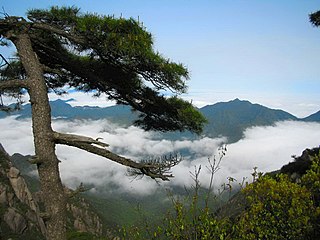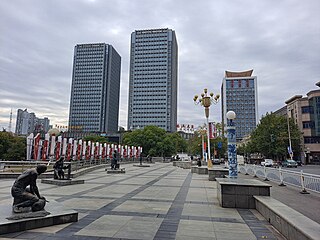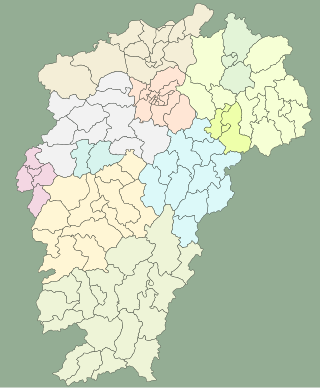
Jiangxi is an inland province in the east of the People's Republic of China. Its major cities include Nanchang and Jiujiang. Spanning from the banks of the Yangtze river in the north into hillier areas in the south and east, it shares a border with Anhui to the north, Zhejiang to the northeast, Fujian to the east, Guangdong to the south, Hunan to the west, and Hubei to the northwest.
Jiujiang University is a local university in Jiujiang, northwestern of landlocked Jiangxi Province in China.

Jingdezhen is a prefecture-level city, in northeastern Jiangxi province, with a total population of 1,669,057 (2018), bordering Anhui to the north. It is known as the "Porcelain Capital" because it has been producing Chinese ceramics for at least 1,000 years, and for much of that period Jingdezhen porcelain was the most important and finest quality in China. The city has a well-documented history that stretches back over 2,000 years.

Nanchang is the capital of Jiangxi Province, China. Located in the north-central part of the province and in the hinterland of Poyang Lake Plain, it is bounded on the west by the Jiuling Mountains, and on the east by Poyang Lake. Because of its strategic location connecting the prosperous East and South China, it has become a major railway hub in Southern China in recent decades.

Mount Lu or Lushan is a mountain situated in Jiujiang, China. It was also known as Kuanglu in ancient times. The mountain and its immediate area are officially designated as the Lushan National Park, and it is one of the most renowned mountains in the country. Mount Lu is located primarily in Lushan City within Jiujiang, although its northern portions are found in Jiujiang's Lianxi District. The oval-shaped mountains are about 25 kilometers (16 mi) long and 10 kilometers (6.2 mi) wide, and neighbors Jiujiang and the Yangtze River to the north, Nanchang to the south, and Poyang Lake to the east. Its highest point is Dahanyang Peak (大汉阳峰), reaching 1,474 meters (4,836 ft) above sea level. Dahayang Peak is also one of the hundreds of steep peaks that tower above the so-called sea of clouds that can encompass the mountain for almost 200 days each year.

The Beijing–Kowloon railway, also known as the Jingjiu railway is a dual track railway connecting Beijing West railway station in Beijing to Shenzhen railway station in Shenzhen, Guangdong Province.

Huanggang is a prefecture-level city in easternmost Hubei Province, China. It is situated to the north of the middle reaches of the Yangtze River and is bounded in the north by the Dabie Mountains and is named after Mount Huanggang. It borders Henan in the north, Anhui in the east and Jiangxi in the south.

Wuxue, formerly Guangji County, is a county-level city on the north shore of the Yangtze River in eastern Hubei province, People's Republic of China. Wuxue falls under the administration of the prefecture-level city of Huanggang.

Jiangxi cuisine, also known as Gan cuisine, is a style of Chinese cuisine derived from the native cooking styles of Jiangxi province in southern China. According to the East China Travel Guide published in 1983, Jiangxi Cuisine has its unique taste which can be described in four Chinese idioms: 原汁原味(aim to bring out the own flavor of the cooking material),油厚不腻(dishes contained a significant amount of oil but the taste are not greasy),口味浓厚(dishes have really thick taste),咸鲜兼辣(always come with spicy solid, salty flavor). Jiangxi cuisine is widely popular within the ordinary family because most of the notable dishes from Jiangxi cuisine are the extension of homely dishes with solid local flavor.
Jiujiang Lushan Airport is an airport serving Jiujiang, a city in the province of Jiangxi in China. The airport began operations on June 18, 1998. All flights from the airport were suspended on March 21, 2015. The airport reopened on October 31, 2021.

The Jiujiang Yangtze River Bridge is a combined road-rail bridge over the Yangtze River near the city of Jiujiang, Jiangxi Province in eastern China. It links Xunyang District of Jiujiang, south of the river, with Xiaochi Town in Huangmei County, Hubei Province, to the north. The central section of the bridge uses a combined arch and truss structure and the bridge is one of the longest continuous truss bridges in the world, with a longest span of 216 meters (709 ft) and a total truss length of 1,314 meters (4,311 ft) =3x162+180+216+180+2x126. The double deck bridge carries four vehicular lanes and two sidewalks on the top deck and two railway tracks on the bottom deck.
Chaisang District, known as Jiujiang County before September 2017, is a district of the city of Jiujiang in Jiangxi Province, China. It has non-contiguous land area, with a smaller exclave to the northeast being separated by Lianxi District and Xunyang District.

Lushan railway station is a railway station located in the Chaisang District of Jiujiang, in Jiangxi province, eastern China.

Gongqingcheng is a sub-prefecture-level city in Jiangxi, People's Republic of China. It was established on 10 September 2010 in the jurisdiction of Jiujiang. It is located 62 kilometres (39 mi) north of Nanchang, the provincial capital. On 1 July 2014, it was re-designated as being directly administered by the province, i.e. a sub-prefecture-level city. Situated in the vicinity of De'an, Yongxiu, and Lushan counties, it lies in the foothills of Mount Lu and lies on the western shore of Poyang Lake. With an area of 193 square kilometres (75 sq mi), it is home to 120,000 people, including 68,000 permanent residents. There are plans for the city to expand the population to 400,000 people. It is the only city in China to be named after the Communist Youth League of China, which in Chinese is abbreviated to "共青团"; hence its name literally means "Communist Youth League City".
The Tongling–Jiujiang railway or Tongjiu railway, is a single-track railroad in eastern China between Tongling in Anhui Province and Jiujiang in Jiangxi Province. The line is 251 km (156 mi) long and follows the south bank of the Yangtze River. Major cities and towns along route include Tongling, Chizhou, Dongzhi County, Pengze, Hukou County and Jiujiang.

The Jiujiang Yangtze River Expressway Bridge, also known as the Second Jiujiang Bridge, is a cable-stayed bridge over the Yangtze River between Huangmei, Huanggang, in Hubei province and Jiujiang, in Jiangxi province. The bridge carries six lanes of traffic on the G70 Fuzhou–Yinchuan Expressway and is the second Yangtze River crossing in Jiujiang. Construction of the bridge started on September 27, 2009, and the bridge was completed on October 28, 2013.

Jiangxi Lushan Football Club is a Chinese professional football club based in Ruichang, Jiangxi, that competes in China League One, the second tier of Chinese football. Jiangxi Lushan plays its home matches at the Ruichang Sports Park Stadium, located within Ruichang. The club was founded in Jiujiang, Jiangxi, and they are owned by the Jiujiang Liansheng Group. The club name Lushan derives from Mount Lu.
Jiangxi University of Technology is a private nonprofit university located in Nanchang, Jiangxi, China which was founded in 1994 and renamed from Jiangxi Blue Sky University in 2012. Jiangxi University of Technology has been ranked number 1 in private universities in China by the Network of Science and Education Evaluation in China since 2007.
The Nanchang–Jiujiang high-speed railway is a high-speed railway currently under construction in Jiangxi Province, China. The railway will have a design speed of 350 kilometres per hour (220 mph). It is part of the Beijing–Hong Kong (Taipei) corridor.

The British concession of Jiujiang was a foreign concession in the Chinese city of Jiujiang which was under the control of the British Empire. Established in 1861 in the aftermath of the Second Opium War as a result of the Treaty of Tientsin, the concession remained under British control until 1929, when it was ceded to the Republic of China under the terms of the Chen-O'Malley Agreement. The only one of its kind in Jiujiang, the concession became home to a sizeable community of European expatriates during its existence.


































